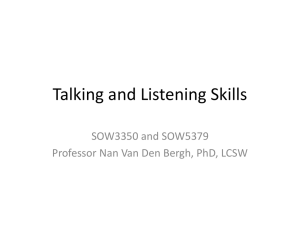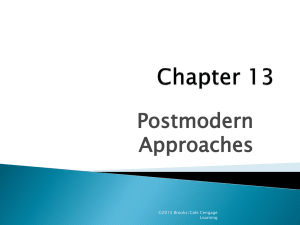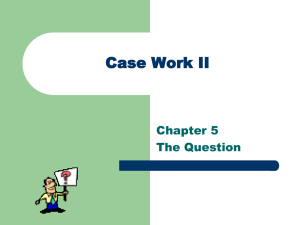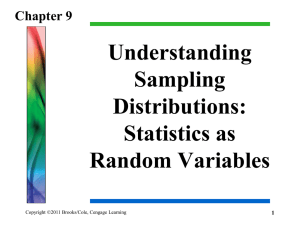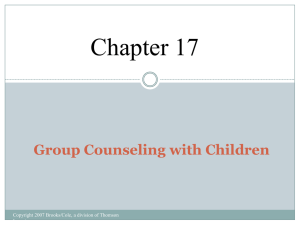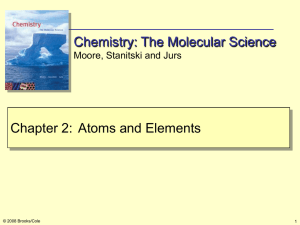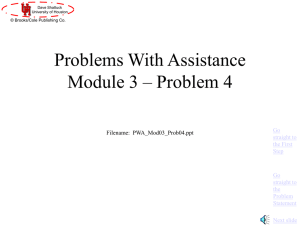Chapter 6 PowerPoint
advertisement
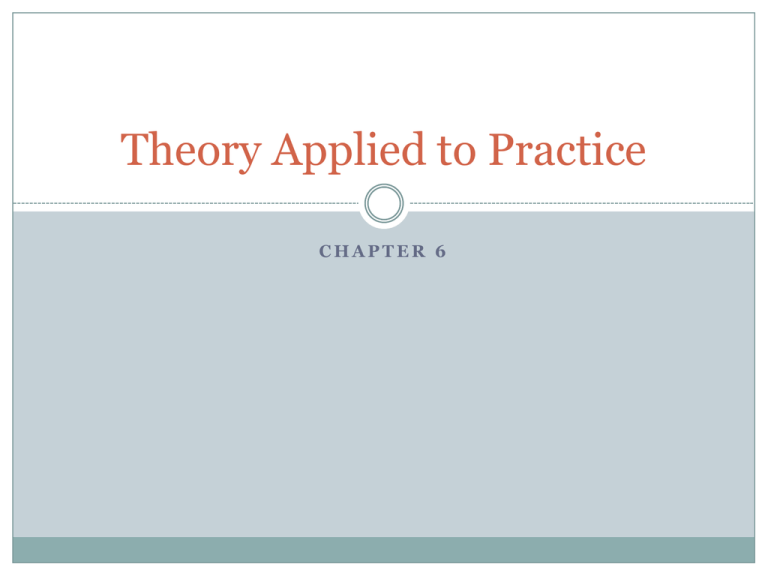
Theory Applied to Practice CHAPTER 6 Five Contemporary Theoretical Orientations 1) The psychodynamic approaches 2) The experiential and relationship-oriented approaches 3) The cognitive behavioral approaches 4) The postmodern approaches 4) The family systems approaches ©2011, Brooks/ Cole Publishing, A Division of Cengage Learning, Inc. Becoming A Helper - Chapter 6 (1) Psychoanalytic Approach Longer-term exploration of personality Main goal: The restructuring of personality Emphasis on transference and countertransference Major techniques: Maintaining the analytic framework free association, interpretation, dream analysis, analysis of resistance, and analysis of transference Many other theoretical models have developed as reactions against psychoanalytic approach ©2011, Brooks/ Cole Publishing, A Division of Cengage Learning, Inc. Becoming A Helper - Chapter 6(2) Adlerian Approach Clients are viewed as creative, active, and decisional Stresses the individual’s positive capacities to live fully in society Therapeutic relationship is a collaborative partnership Social interest: A sense of identification with humanity, a feeling of belonging, and a concern with bettering society ©2011, Brooks/ Cole Publishing, A Division of Cengage Learning, Inc. Becoming A Helper - Chapter 6(3) Adlerian Approach • Inferiority feelings, the wellspring of creativity, often motivate people to strive for mastery, superiority, and perfection • Focus on challenging clients’ mistaken notions and faulty assumptions • Emphasis on examining lifestyle and clients’ functioning in the life tasks • Cognitive, behavioral, and experiential techniques are used (e.g., encouragement, early recollections, homework) ©2011, Brooks/ Cole Publishing, A Division of Cengage Learning, Inc. Becoming A Helper - Chapter 6(4) Existential Approach We define ourselves by our choices Freedom and responsibility go together Anxiety is part of the human condition Death gives significance to life Emphasis is on understanding the world of the client ©2011, Brooks/ Cole Publishing, A Division of Cengage Learning, Inc. Becoming A Helper - Chapter 6(5) Person-Centered Approach • Clients are at the center of the helping process • Clients are able to change without a high degree of structure and direction from the therapist • The aim of counseling is to assist clients’ growth process • Effective helping is based on the quality of the helping relationship • Techniques are secondary to the counselor’s attitudes ©2011, Brooks/ Cole Publishing, A Division of Cengage Learning, Inc. Becoming A Helper - Chapter 6 (5) Gestalt Approach Focuses on here-and-now experiencing and present awareness With awareness, clients are able to change Counselors suggest experiments that are done by clients (e.g., symbolic dialogues, exaggerating a gesture) The approach emphasizes the I/Thou dialogue The focus is on doing rather than “talking about” ©2011, Brooks/ Cole Publishing, A Division of Cengage Learning, Inc. Becoming A Helper - Chapter 6 (6) Cognitive Behavioral Approaches Cognitive behavioral approaches share these attributes: a collaborative relationship between client and therapist psychological distress: the result of faulty cognitive processes a focus on changing cognitions to produce desired changes in affect and behavior a time-limited and educational treatment ©2011, Brooks/ Cole Publishing, A Division of Cengage Learning, Inc. Becoming A Helper - Chapter 6 (7) Behavior Therapy The focus of this approach is on: observable behavior current determinants of behavior learning experiences to promote change rigorous assessment and evaluation ©2011, Brooks/ Cole Publishing, A Division of Cengage Learning, Inc. Becoming A Helper - Chapter 6(8) Rational Emotive Behavior Therapy • Emotional problems are the result of one’s beliefs, not events • The aim: to change disturbances in thinking, feeling, and behaving • Cognitive techniques: teaching clients coping statements, disputing faulty beliefs, psychoeducation methods • Emotive techniques: rational emotive imagery, humor, shame- attacking exercises, role playing, unconditional acceptance • Behavioral techniques: self-management strategies and carrying out homework in daily life ©2011, Brooks/ Cole Publishing, A Division of Cengage Learning, Inc. Becoming A Helper - Chapter 6(9) Cognitive Therapy Changing how people think tends to result in changing feeling and behaving (schema restructuring) Clients are encouraged to weigh the evidence in support of their beliefs This approach emphasizes a collaboration between counselor and client Counselors guide clients to discover the connection between thinking, feeling, and behaving ©2011, Brooks/ Cole Publishing, A Division of Cengage Learning, Inc. Becoming A Helper - Chapter 6 (10) Reality Therapy • Based on choice theory, reality therapy is active, directive, and didactic • Emphasis is on total behavior: acting, thinking, feeling, and physiology • Wubbolding (2000) summarizes the procedures for reality therapy through the WDEP model: W= wants, needs, and perceptions D= direction and doing E= evaluation of total behavior P= planning and commitment ©2011, Brooks/ Cole Publishing, A Division of Cengage Learning, Inc. Becoming A Helper - Chapter 6(11) Solution-Focused Brief Therapy Techniques focus on the future and how best to solve problems rather than on understanding the cause of problems Exception questions ask clients to identify times when their problems did not exist The miracle question allows clients to think of their life without their problem Scaling questions require clients to rate their improvement on a scale of zero to 10 The approach tends to be brief and collaborative ©2011, Brooks/ Cole Publishing, A Division of Cengage Learning, Inc. Becoming A Helper - Chapter 6(12) Narrative Therapy • Examines people’s stories and the meaning of their stories • Based on assumption that there is no absolute reality • Clients are invited to view their stories from different perspectives and co-create an alternative life story • Process involves identifying how societal standards are internalized by the client in a limiting manner • Therapist collaborates with client and avoids predicting, interpreting, or pathologizing • Therapist and client engage in externalizing conversations ©2011, Brooks/ Cole Publishing, A Division of Cengage Learning, Inc. Becoming A Helper - Chapter 6 (13) Family Systems Approaches • Individuals are best understood through assessing interactions within the entire family • A client’s problematic behavior may serve a purpose for the family • Problems are often passed on over many generations • Actions by any individual in the family influence other family members • This approach focuses on here-and-now interactions in the family system ©2011, Brooks/ Cole Publishing, A Division of Cengage Learning, Inc. Becoming A Helper - Chapter 6 (14) An Integrative Approach to the Helping Process Each theory has something unique to contribute to a counselor’s style Remain open to the value inherent in each of the theories of counseling It is possible to draw techniques from most of the contemporary theoretical models Developing an integrative perspective takes much study and clinical practice ©2011, Brooks/ Cole Publishing, A Division of Cengage Learning, Inc. Becoming A Helper - Chapter 6 (15) Important Terms to Know Adlerian approach Behavior therapy Choice theory Cognitive behavioral approaches Cognitive therapy Cycle of counseling Exception questions Existential perspective Experiential approaches Family systems perspective Family therapy Gestalt therapy Inferiority feelings Integrative model Life tasks Lifestyle Miracle question Narrative therapy Person-centered approach Post modern approaches Pre-therapy change Psychoanalytic approach Psychodynamic approaches Rational emotive behavior therapy Reality therapy Relationship oriented approaches Restricted existence Scaling questions Social interest Solution-focused brief therapy Summary feedback Total behavior WDEP model
